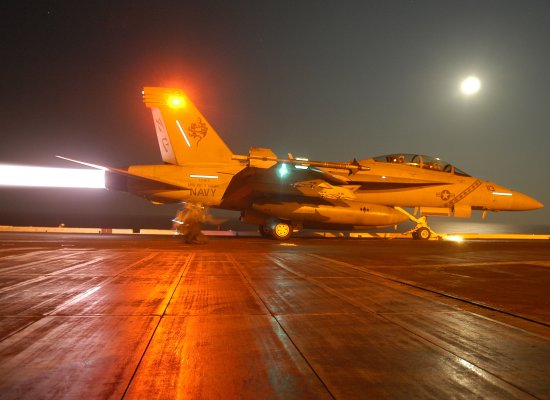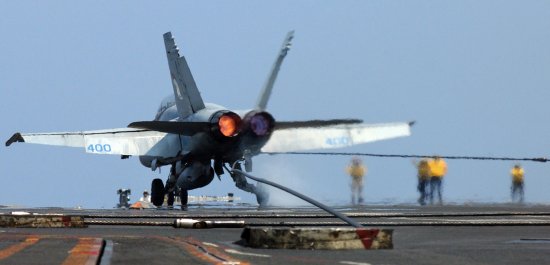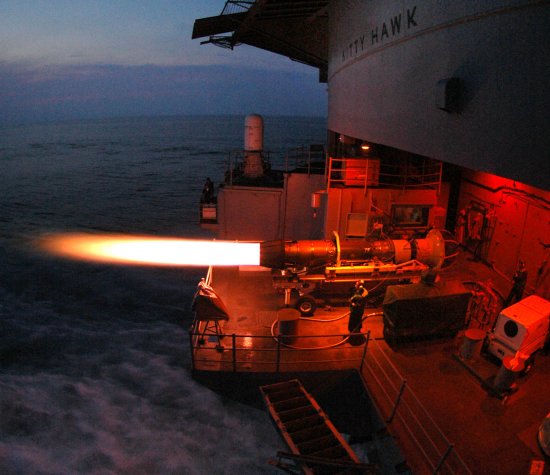|
||||||||||
|
|
||||||||||
|
||||||||||
|
|
||||||||||

Aircraft carriers have very little space available for takeoff compared to a runway on land. Planes are instead connected to a catapult shuttle by means of a T-bar on the nose landing gear. After the connection is made, the pilot increases the engine throttle and engages the afterburner to produce a high level of thrust as shown in the above F-18 Super Hornet photo. A final series of checks is performed both by the pilot and crew aboard the carrier before the catapult is activated. The force of the catapult pulling the plane down the deck combined with the engine power is enough to accelerate a jet to 165 mph (265 km/h) in just two seconds and allows the aircraft to takeoff in a distance of only 300 ft (90 m).
Another case when a plane is directly connected to an aircraft carrier comes during landing. Just as takeoff space is extremely limited aboard a ship, so is the space available for landing. A method of rapidly decelerating an aircraft from landing speed to a stop is called the arrester gear. The most visible part of the arresting system is a series of steel cables stretched across the aft flight deck. As a plane descends, it extends a bar from the lower aft fuselage called a tailhook that is about 8 ft (2.5 m) long. The end of this bar has a hook shape designed to catch one of the arresting cables and slow the plane to a stop. The cable is tensioned so that any aircraft comes to a complete stop at about the same place on the deck no matter how large or heavy it is. The arresting system can bring any carrier-based plane from its landing speed around 150 mph (240 km/h) to a standstill in a distance of about 320 ft (100 m).

Readers may be surprised to learn that as a plane lands, its engines are also throttled up to maximum power and the afterburners are engaged. The reason is that if the aircraft fails to latch onto one of the cables, it needs full engine power to takeoff again and loop around for another landing attempt. An example can be seen above where the afterburners of an F-18 Hornet are in use as the plane lands.
A final situation to consider involves an engine test facility located on the aft end of US aircraft carriers. The aft hangar deck is home to an area called the jet shop where engines are repaired and maintained while the ship is at sea. Just behind the shop itself on the fantail is a test stand where engines can be tested to ensure repairs have been successful. The test area is outdoors and engines are positioned so the exhaust points off the end of the ship. Some of the maintenance crew work on the exposed deck to make any adjustments to the engine and other equipment while the rest monitor the tests from a control room that overlooks the deck.
Testing includes running an engine for several minutes at different power settings, up to and including full afterburner, while data is collected to measure how well the jet is functioning. This work is mostly done at night so the crew can use special cameras that observe the exhaust plume. In addition, the tests cannot be done during flight operations since the fantail is just below the end of the flight deck, and air operations tend to be less frequent in the early hours of pre-dawn darkness.

While in college, one of my classes visited an aircraft carrier in port where we received a tour of the Aviation Intermediate Maintenance Department (AIMD) that includes the jet shop. One of the other students asked the obvious question, "How fast does one of these jet engines make the ship go?" The crewman we spoke to said every group that visits asks the same thing. He went on to explain that even the most powerful engine they worked on, the General Electric F110 used on the F-14 Tomcat, couldn't come close to affecting the ship's speed. It would take 36 of these engines operating at maximum afterburner to nudge the ship just enough to break the force of friction!
Another friend of mine was lucky enough to spend time aboard a carrier during air operations at sea. He commented
on the noise of the takeoffs and landings even while deep inside the ship well below the flight deck. Often times,
a landing aircraft had caught an arresting cable but the pilot took several seconds to shut off the afterburners.
Even with its massive size, this made the whole ship vibrate. He also commented that the air boss who commands the
ship's control tower reminded one pilot by joking, "You can shut off the engines now. You won't make the ship go
any faster."
- answer by Molly Swanson, 29 April 2007
Related Topics:
Read More Articles:


|
Aircraft | Design | Ask Us | Shop | Search |

|
|
| About Us | Contact Us | Copyright © 1997-2023 | |||
|
|
|||